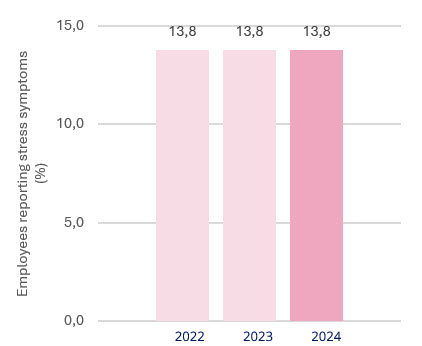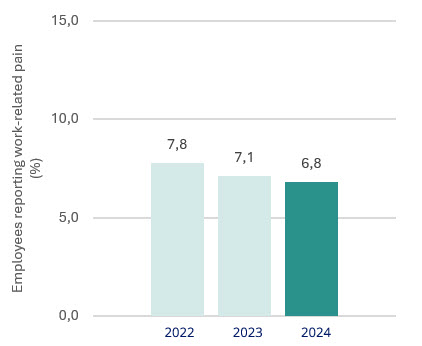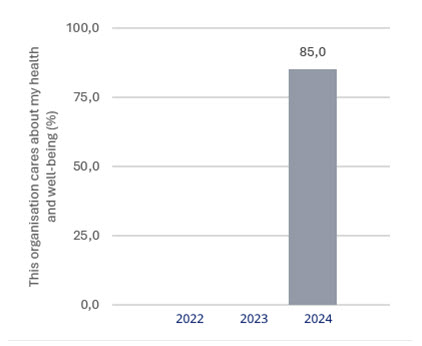Our strategy revolves around driving change in health, safety, and well-being for our people. Together we strive for a working environment and organisational culture, where we as a company proactively support our employees to thrive both physically and mentally, and live their life to the fullest.
We offer a healthy and engaging workplace, supported by a comprehensive Health and Safety programme. To this end, we have implemented our Health and Safety management system across our entire global organisation to ensure such conditions for all employees and contractors.
Our corporate values, the Novo Nordisk Way, with Essential no. 8 “We have a healthy and engaging working environment”, clearly states that health and safety is a key priority. Our global Health and Safety policy is based on our focus on prevention and continual improvements.
We strive to uphold a safe working environment and promote the health of our people. This means that we:
- Operate by high Health and Safety standards throughout the world
- Promote a healthy lifestyle
- Ensure our employees are involved in how we maintain and improve health and safety
- Hold our employees accountable for their actions regarding workplace safety
- Ensure that the working environment is not compromised for economic or productivity reasons
- Fulfil applicable legal requirements
- Follow relevant international conventions.
The Health and Safety policy is governed and implemented through our global Health and Safety management system, which is described in a global procedure for all leaders and health and safety professionals. The management system defines that health and safety of our employees is a managerial responsibility. The procedure contains specific Health and Safety requirements regarding e.g., risk assessments and emergency procedures and preparedness. The global procedure outlines requirements for a range of Health and Safety aspects e.g. chemical and biological hazards, noise, ergonomics, machine safety and psycho-social working environment. The global procedure is supported by local instructions, reuirements and dedicated training of managers and Health and Safety staff as well as annual basic Health and Safety training of all employees globally. All production facilities have Health and Safety certifications according to ISO45001 and are audited regularly both internally and externally.
Every year, an organisational bottom-up management review is conducted with the Novo Nordisk Executive Management team as the governing body.
The Health and Safety management system ensures that we involve our own workforce, including Health and Safety representatives, in target setting, performance tracking and when identifying lessons learned. Insights from the annual employee engagement survey, Evolve, and reporting of safety incidents inform our target setting.
Our Health and Safety strategy revolves around making continuous improvements. Through a global partnering approach, all business areas commit to specific targets and initiatives for identified Health and Safety challenges, based on the annual management review process and Health and Safety performance.
The strategy is implemented in a partnering approach, with all business areas and aims to involve, inspire, and enable managers and employees to make sure that our people leave work every day as mentally healthy and physically fit as when they arrived. We want everyone in Novo Nordisk to act on the safety, physical and mental health and well-being of themselves and their colleagues.
To measure progress against our local and global Health and Safety initiatives, we have set targets applicable across our global operations (excluding NNE) to reduce and prevent accidents from occurring.
The Health and Safety strategy drives improvements on our three focus areas and targets for safety, mental health and well-being, and physical well-being/ergonomics, illustrated in the list below:
Novo Nordisk target: Annual improvement of accidents with absence per million work hours.
Our safety target is based on recordable work-related accidents with an aim of annual improvements in Lost Time Accident Frequency (LTAF).
The rate of work-related accidents has decreased 7.7% (1.2ppm in 2024 compared to 1.3ppm in 2023[1]). The decrease in LTAF is primarily driven by an increased safety focus from top management, based on awareness of the elevated risk level connected to the expansion situation. This focus has been communicated down through line of business and has been supported by more clear safety requirements and safety behavior initiatives.
In 2024, Novo Nordisk had 173 accidents with reported absence compared to 159[2] in 2023, which is in line with the increase in number of employees. Furthermore, Novo Nordisk had 0 work-related fatalities in 2024 compared to 1 in 2023.
In 2024 Novo Nordisk had a number of serious incidents, primarily in areas conducting activities to expand production capacity. While serious, these incidents only had minor impact on our employees, primarily in terms of need for psychological support, no serious injuries were sustained. Immediately after these serious incidents several actions were taken across Novo Nordisk. A set of elevated requirements and actions to ensure process confirmation was initiated, e.g. sites were asked to map their high-hazard activities related to both operation and construction work. This was to ensure that work permits are in place for all non-routine high-hazard work, including hot work, working at height etc., and that qualified fire guards are in place during work where needed. Moreover, emergency procedures have been reviewed and emergency response teams are being established where not already in place. From 2025 Novo Nordisk will introduce a new, global safety target to sustain and enhance enterprise-wide focus on driving prevention of potential and serious incidents and fatalities.
Further, transportation and traffic accidents are identified as a major risk area for medical representatives working in countries with unsafe public infrastructure. Preventive measures are prioritised and initiated where relevant in the organisation.
References
[1] In 2023 was the reported LTAF
1.5ppm. However, when considering the new calculation method for
LTAF as of 01-Jan-2024, the LTAF for 2023 was 1.3ppm. The
calculation method was changed to align with new requirements on
ESG reporting and now follows the international standard
definition. The working hours was changed from 1,600 hours a
year to 2,000 hours a year (decreasing LTAF) and FTE numbers are
now based on an average FTE number instead of year-end figures
(increasing LTAF).
[2] The Annual report 2023 stated 153 accidents with absence. Six (6) accidents with absence that happened in 2023 were registered after closure of the Annual report 2023.
EVP area target: 10% annual improvement of employees reporting stress symptoms.
To improve mental health and well-being we set targets to reduce the number of employees reporting stress by 10% year on year. The performance is measured in the annual employee engagement survey, Evolve. In the survey, stress is defined as a situation where the employee feels tense, restless, nervous or troubled, or unable to sleep at night due to thoughts about their problems.
Employees responding that they experienced symptoms of stress was improved by 0%, (13.8% in 2024 compared to 13.8% in 2023), hence the target of 10% annual improvement has not been met. The reasons are many and vary across the organisation. The overarching cause is the growth of the company with the increased ‘burden’ of onboarding and training of new employees by the more experienced employees who also must deliver on daily operations. Moreover, in general the growth of the company has led to multiple organisational changes which are known risk factors to mental well-being.
Following Evolve 2024 a new process has been implemented, where specific manager and HR business partner training and follow-up guidance with focus on mental well-being and psycho-social factors has been offered for teams in the bottom-quartile of the Engagement Index. Further, a global Mental well-being delivery model targeting areas with a high stress level has been implemented. This delivery model combined with an increase of training offers to leaders, Health and Safety partners, HR Business partners and Health and Safety representatives (employee elected or appointed), provides an extensive support to both reduce and prevent stress.
The preventive approach focuses on organizational aspects of psycho-social factors and leadership, with attention to, job design and relations. In connection with the annual employee engagement survey all leaders receive a risk assessment highlighting relevant focus areas for potential improvements through six preventive well-being aspects: influence, recognition, meaningfulness, social support, predictability and demands/resources.
In 2025 we plan to implement a tool for risk assessment of organisational changes and guidance on actions to mitigate stress based on risk profiles. We plan to further refine and carry through on the evolve follow-up guidance for bottom quartile and expand offerings and training. Furthermore, we plan to ensure adherence to the global model of stress prevention in areas where not yet implemented and continue offerings according to the mental well-being delivery model.
Moreover, a global anti-harassment framework has been implemented to prevent workplace harassment. Trainings on respectful tone and anti-harassment is offered to human resources experts and managers globally.
Global leadership guidelines have been developed, to enable leaders and HR resource persons to build capabilities in return-to-work guidance after sick-leave, as well as for specific conditions, disease groups and neurodiversity in close collaboration with the Global functional area for Diversity Equity Inclusion and Belonging.
EVP area target: 5% annual improvement of employees reporting work-related pain.
To improve physical well-being, we set targets to reduce the number of employees reporting work-related pain by 5% year on year. Progress is measured by a question asking for symptoms of work-related physical pain, in the annual employee engagement survey, Evolve.
Reported symptoms of work-related physical pain decreased 4.2% (6.8% in 2024 compared to 7.1% in 2023), hence the target of 5% annual improvement has not been met. Monitoring occurs on an ongoing basis and is reported annually. A global delivery model offering support by specialist is offered for areas with high levels of employees with work-related pain. The offer involves risk assessment in relation to physical working environment with focus on ergonomics, to support business units to identify and systematically address root causes. Further, interventions in Denmark and competency building of local Health and Safety resources in work-related pain at global production sites have been conducted.
Since 2015, we have had requirements for manual lifting of loads, at a maximum load of lifting at 15kg. Similarly global guidance for preventing repetitive and monotonous work is implemented.
The employee health promotion programme is adapted by local
ambassadors, its content is co-created by employees across the
organisation and the programme is built upon six pillars to help
health promotion and prevention amongst Novo Nordisk employees
globally:
1. Physical activity
We believe that regular physical
activity can help our employees improve physical fitness and
counterbalance the negative effects of an inactive lifestyle.
Moreover, physical activity provides social interaction and the opportunity to be involved in the community. We support and enable employees in being physically active during working hours.
Goal : all employees have opportunities to exercise.
2. Individual mental health and well-being
We
believe that positive mental health enable people’s ability to realize
their full potential, cope with the normal stressors of life and work
productively and fruitfully.
Therefore, we support and enable employees to live a balanced life and maintain or develop positive mental health by offering information and opportunities to apply various individual and social coping techniques.
Goal : all employees can access knowledge and tools to
act on their mental well-being.
3. Nicotine cessation
We believe that nicotine cessation
can considerably improve your health and prevent chronic diseases.
Moreover, it may increase your life expectancy. We support and enable employees who want to quit nicotine.
Goal : all employees have support options to quit
nicotine.
4. Healthy eating
We believe that healthy eating,
regular meals during the day, and proper hydration are all important
in maintaining stable energy levels throughout the day and in
supporting our employees’ daily activity levels and goals.
We support and enable employees in eating healthy.
Goal : all employees have information and access to
healthy food, so the healthy choice is the easy choice.
5. Health checks
We believe that health checks motivate
our employees to gain insight into their own health and to act upon it.
We support and enable employees in attending health checks during working hours at least every second year.
Goal : all employees have access to free health checks
and guidance on how to act on their health.
6. Weight management
We believe that reaching and
maintaining a healthy weight is important for overall health and can
help you prevent life-style and chronic diseases.
Moreover, we believe that a healthy environment makes it easier (and more sustainable) to manage your weight.
Goal : employees have access to weight management support options.
The percentage of employees in Novo Nordisk's own workforce who are covered by our health and safety management system based on legal requirements and/or recognised standards or guidelines is defined as the number of employees covered by health and safety management systems (headcount) divided by all employees (headcount).
Total number of work-related injuries causing at least one day of absence in addition to the day of the accident.
Work-related accidents resulting in the death of an employee. All employees (headcount), permanent, temporary, and non-guaranteed hours, have been included in this metric.
Rate of recordable work-related accidents for our own workforce, measured in accidents per million hours worked, also referred to as the lost-time accident frequency (LTAF). Contractors, visitors, employees on unpaid leave, interns, and Bachelor's and Master's thesis students are not included. The number of hours worked is based on 2,000 working hours annually per full-time equivalent and the monthly records of number of employees converted into full-time equivalents.
Reported via the annual employee survey Evolve. In the survey, stress is defined as a situation where the employee feels tense, restless, nervous or troubled, or unable to sleep at night due to thoughts about their problems. Regarding symptoms of physical pain, the survey asks if an employee's work generally causes them physical pain. The two relative targets of improving mental and physical wellbeing are measured as the percentage of employees responding 'Quite much' or 'Very much' for mental wellbeing or 'Unfavourable' to the statement related to physical pain.



